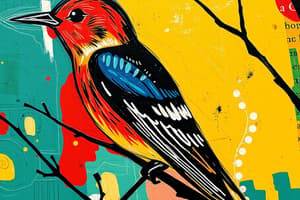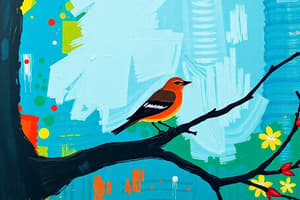Podcast
Questions and Answers
Harper Lee's novel, To Kill a Mockingbird, is set in the 1950s during the height of the Civil Rights Movement.
Harper Lee's novel, To Kill a Mockingbird, is set in the 1950s during the height of the Civil Rights Movement.
False (B)
Scout Finch narrates the story as an adult reflecting on her childhood experiences in Maycomb.
Scout Finch narrates the story as an adult reflecting on her childhood experiences in Maycomb.
True (A)
Atticus Finch is criticized by some in Maycomb for defending Bob Ewell in court.
Atticus Finch is criticized by some in Maycomb for defending Bob Ewell in court.
False (B)
Calpurnia serves primarily as a cook for the Finch family, without much emotional connection to Scout and Jem.
Calpurnia serves primarily as a cook for the Finch family, without much emotional connection to Scout and Jem.
The character of Dill is based on Harper Lee's childhood friendship with Truman Capote.
The character of Dill is based on Harper Lee's childhood friendship with Truman Capote.
Tom Robinson's case gains significant support from the Maycomb community due to his evident innocence.
Tom Robinson's case gains significant support from the Maycomb community due to his evident innocence.
Bob Ewell is genuinely remorseful for his actions and apologizes to Atticus after the trial.
Bob Ewell is genuinely remorseful for his actions and apologizes to Atticus after the trial.
Mayella Ewell is portrayed as a cruel and heartless character throughout the novel, with no redeeming qualities.
Mayella Ewell is portrayed as a cruel and heartless character throughout the novel, with no redeeming qualities.
Boo Radley is a figment of the children's imagination, symbolizing their fears and fantasies.
Boo Radley is a figment of the children's imagination, symbolizing their fears and fantasies.
The primary theme of To Kill a Mockingbird is the celebration of rural Southern life.
The primary theme of To Kill a Mockingbird is the celebration of rural Southern life.
The mockingbird in the title represents individuals who are innocent and harmless, often victimized by society.
The mockingbird in the title represents individuals who are innocent and harmless, often victimized by society.
The Radley Place is perceived as a welcoming and friendly home by the children in Maycomb.
The Radley Place is perceived as a welcoming and friendly home by the children in Maycomb.
The courtroom in To Kill a Mockingbird symbolizes unwavering justice and fairness.
The courtroom in To Kill a Mockingbird symbolizes unwavering justice and fairness.
The gifts that Boo Radley leaves for Jem and Scout in the knothole of the tree represent his animosity towards them.
The gifts that Boo Radley leaves for Jem and Scout in the knothole of the tree represent his animosity towards them.
The mad dog that Atticus shoots symbolizes the physical danger threatening Maycomb.
The mad dog that Atticus shoots symbolizes the physical danger threatening Maycomb.
Harper Lee wrote To Kill a Mockingbird from a third-person perspective to provide a broader view of Maycomb society.
Harper Lee wrote To Kill a Mockingbird from a third-person perspective to provide a broader view of Maycomb society.
Lee's writing style is complex and formal, reflecting the serious themes explored in the novel.
Lee's writing style is complex and formal, reflecting the serious themes explored in the novel.
To Kill a Mockingbird had little impact on the Civil Rights Movement at the time of its publication.
To Kill a Mockingbird had little impact on the Civil Rights Movement at the time of its publication.
The Scottsboro Boys case highlighted racial injustice in the legal system and influenced Harper Lee's writing of the novel.
The Scottsboro Boys case highlighted racial injustice in the legal system and influenced Harper Lee's writing of the novel.
Following Tom Robinson's death, Atticus decides to leave Maycomb due to the overwhelming prejudice.
Following Tom Robinson's death, Atticus decides to leave Maycomb due to the overwhelming prejudice.
Flashcards
To Kill a Mockingbird
To Kill a Mockingbird
A novel by Harper Lee published in 1960, set in Maycomb, Alabama, during the 1930s, focusing on Scout Finch's childhood and racial injustice.
Scout Finch
Scout Finch
The narrator and protagonist of 'To Kill a Mockingbird', an intelligent, curious, and tomboyish young girl.
Jem Finch
Jem Finch
Scout's older brother who is protective and adventurous in 'To Kill a Mockingbird'.
Atticus Finch
Atticus Finch
Signup and view all the flashcards
Calpurnia
Calpurnia
Signup and view all the flashcards
Tom Robinson
Tom Robinson
Signup and view all the flashcards
Bob Ewell
Bob Ewell
Signup and view all the flashcards
Boo Radley
Boo Radley
Signup and view all the flashcards
The Trial of Tom Robinson
The Trial of Tom Robinson
Signup and view all the flashcards
Moral Courage
Moral Courage
Signup and view all the flashcards
Childhood Innocence
Childhood Innocence
Signup and view all the flashcards
Social Inequality
Social Inequality
Signup and view all the flashcards
The Mockingbird
The Mockingbird
Signup and view all the flashcards
The Courtroom
The Courtroom
Signup and view all the flashcards
First-Person Narrative
First-Person Narrative
Signup and view all the flashcards
Jim Crow Laws
Jim Crow Laws
Signup and view all the flashcards
The Great Depression
The Great Depression
Signup and view all the flashcards
The Scottsboro Boys Case
The Scottsboro Boys Case
Signup and view all the flashcards
The Civil Rights Movement
The Civil Rights Movement
Signup and view all the flashcards
The Pulitzer Prize
The Pulitzer Prize
Signup and view all the flashcards
Study Notes
- Harper Lee's "To Kill a Mockingbird" was released in 1960.
- The story unfolds in Maycomb, Alabama, a fictional town, during the 1930s.
- Scout Finch, a young girl, is the focus of the narrative as she comes of age and experiences racial injustice.
Characters
- Scout Finch narrates the story as the main character, depicted as a smart, inquisitive, and boisterous young girl.
- Jem Finch is Scout's older brother, portrayed as adventurous and protective.
- Atticus Finch, their father, is a lawyer known for his strong moral compass and integrity.
- Calpurnia, the family's black housekeeper, acts as a maternal figure, imparting important life lessons to Scout and Jem.
- Tom Robinson, a black man, faces false accusations of assaulting Mayella Ewell and is unjustly convicted due to racial bias.
- Bob Ewell is Mayella's father who is portrayed as impoverished, uneducated, and deeply racist, embodying the worst aspects of Maycomb.
- Mayella Ewell, Bob's daughter, is portrayed as a lonely, abused individual who accuses Tom Robinson of assault.
- Boo Radley, a secluded neighbor, sparks curiosity and fear among the children in the town.
Plot Summary
- Scout narrates the story, looking back on her childhood experiences in Maycomb.
- Scout, Jem, and their friend Dill spend their summers playing, particularly focusing on their fascination with Boo Radley.
- Atticus takes on the challenging task of defending Tom Robinson, a black man wrongly accused of assaulting Mayella Ewell.
- The trial reveals the entrenched racism and prejudice prevalent in Maycomb.
- Despite evidence showing his innocence, an all-white jury convicts Tom Robinson.
- Tom Robinson attempts to escape from prison but is shot and killed.
- Bob Ewell, seeking revenge, targets Atticus and attacks Jem and Scout.
- Boo Radley steps in to protect Jem and Scout, ultimately killing Bob Ewell.
- Sheriff Tate makes the decision to conceal the truth to shield Boo Radley from unwanted attention.
Themes
- Racial injustice is a central theme, illustrating the rampant racism and prejudice present in the American South during the 1930s through Tom Robinson's trial.
- Atticus Finch embodies moral courage by defending Tom Robinson, despite facing disapproval and threats from the community.
- The loss of childhood innocence is explored through Scout and Jem's experiences as they navigate the complexities of the adult world.
- Prejudice and discrimination extend beyond racial issues, as seen in the community's treatment of Boo Radley due to fear and misunderstanding.
- Social inequality is highlighted, contrasting the lives of the Finch family with those of the Ewell family.
- The story promotes empathy and understanding, emphasizing the importance of seeing things from another's perspective, as taught by Atticus.
- Justice and fairness are questioned as the legal system fails Tom Robinson.
- The importance of conscience is highlighted through Atticus's unwavering commitment to doing what is right, despite facing unpopularity.
- The hypocrisy within Maycomb society is exposed, revealing its selective morality and prejudiced attitudes.
- The conflict between good and evil is represented by Atticus and Bob Ewell, with good prevailing through Boo Radley's heroic actions.
Symbolism
- The mockingbird represents innocence and harmlessness with both Tom Robinson and Boo Radley.
- The Radley Place symbolizes mystery, fear, and the unknown.
- The courtroom represents justice and the legal system, including its flaws and biases.
- Boo Radley's gifts to Jem and Scout symbolize his hidden affection and desire for connection.
- The mad dog symbolizes the disease of prejudice affecting Maycomb.
Style and Narrative
- Scout narrates the story using the first-person perspective.
- Harper Lee employs clear and straightforward language to present the story from a child's viewpoint.
- The narrative structure alternates between humorous anecdotes and serious social commentary.
- Vivid imagery and descriptive language effectively portray Maycomb's setting.
- The novel follows a coming-of-age narrative, exploring loss of innocence and the difficulties of growing up in a prejudiced society.
Historical Context
- The Great Depression, a period marked by economic hardship and social unrest in the United States, provides the backdrop for the novel.
- The Jim Crow laws, which enforced racial segregation and discrimination, were still in effect in the South during the 1930s.
- The Scottsboro Boys case, where nine black teenagers were falsely accused of raping two white women, serves as a real-life example of racial injustice that influenced the novel.
- The Civil Rights Movement, gaining momentum in the 1950s and 1960s, coincided with the novel's publication.
- "To Kill a Mockingbird" played a role in raising awareness about racial injustice and contributing to the growing demand for civil rights.
Critical Reception
- "To Kill a Mockingbird" quickly became a bestseller and was awarded the Pulitzer Prize in 1961.
- It has received acclaim for addressing racial injustice, its memorable characters, and its poignant narrative.
- Some critics argue that the novel idealizes the South and simplifies the issue of racism.
- The novel has faced challenges and bans in certain schools and libraries due to racial slurs and mature themes.
- "To Kill a Mockingbird" is still widely read and studied in American literature.
Studying That Suits You
Use AI to generate personalized quizzes and flashcards to suit your learning preferences.




